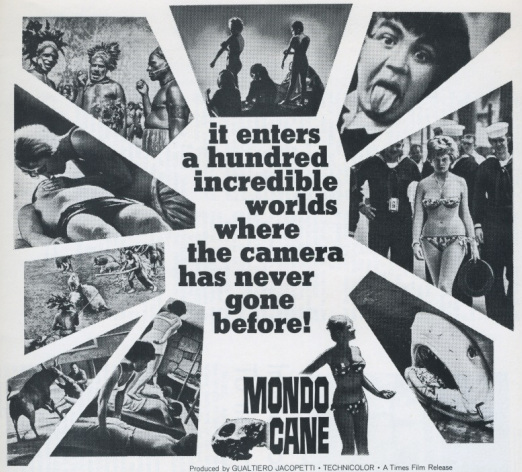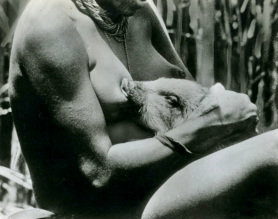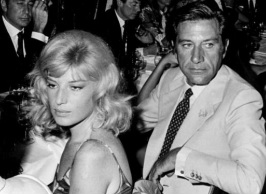Mondo Cane (1962)
Though not the first, Mondo Cane is the "mondo" film that provided the genre with its name. Where previous faux documentaries had merely muddied ethnography with a huckster's dose of exploitation, a trend shared by all so-called "shockumentaries," Mondo Cane remains the genre's landmark for its cunning evisceration, through ironic editing and narration, of the comforting lies entwined in the bourgeois culture of its viewers. The foolishness and ludicrous inconsistencies of human existence are laid bare with startling juxtapositions of footage from around the world, from the world's wealthiest inhabitants to its most hungry and desperate, in a cynic's-eye-view of mankind's follies that is as audacious today as it was back in 1962.

Translated into English as "It's A Dog's Life," the film's title spawned the "mondo" craze that proliferated for decades afterwards with mostly inferior (Mondo Bizarro, Mondo Magic) or unrelated (Mondo Topless, Mondo Trasho) films that attempted to either capitalize on, or pay tribute to, the original. Though lacking the more extreme content of its subsequent imitators, Mondo Cane remains impressive through its ability to startle, amuse, and then sicken the viewer in rapid succession.
The film's focus is often on the uneasy relationship between the human and animal kingdoms. In one of the most outrageous juxtapositions, an exclusive Pasadena pet cemetery for the pampered pups and pusses of the Hollywood elite is contrasted with a restaurant in Taipei, where caged dogs are selected by customers before being killed, cooked, and eaten.
In a subsequent scenic pairing, bulls are beheaded by swordsmen in Singapore while their bovine cousins in Portugal maim foolhardy pedestrians during an event reminiscent of the famous Running of the Bulls in Pamplona. Snakes are skinned and eaten in Malaysia, but they're venerated as holy objects in the village of Cucullo in Abruzzi for a celebration marking St. Dominic's Day. Viewers are introduced to a piglet as it's breast-fed by a woman grieving her dead infant in New Guinea, followed by a grotesque barbecue in which pigs are brutally beaten to death with clubs and then roast whole over open fires. In what might be the film's most repulsive sequence, Malaysian fishermen seek "revenge" against shark attacks by capturing the creatures, shoving poisonous sea urchins down their throats, and then releasing them into the sea to suffer a slow, agonizing death. Prior scenes of shark attack victims, amputees whose livelihoods have been reduced to foraging for fins on the beach, do little to justify the cruelty inflicted on beasts with no comprehension of the concepts of guilt or retribution.
The film's focus is often on the uneasy relationship between the human and animal kingdoms. In one of the most outrageous juxtapositions, an exclusive Pasadena pet cemetery for the pampered pups and pusses of the Hollywood elite is contrasted with a restaurant in Taipei, where caged dogs are selected by customers before being killed, cooked, and eaten.
In a subsequent scenic pairing, bulls are beheaded by swordsmen in Singapore while their bovine cousins in Portugal maim foolhardy pedestrians during an event reminiscent of the famous Running of the Bulls in Pamplona. Snakes are skinned and eaten in Malaysia, but they're venerated as holy objects in the village of Cucullo in Abruzzi for a celebration marking St. Dominic's Day. Viewers are introduced to a piglet as it's breast-fed by a woman grieving her dead infant in New Guinea, followed by a grotesque barbecue in which pigs are brutally beaten to death with clubs and then roast whole over open fires. In what might be the film's most repulsive sequence, Malaysian fishermen seek "revenge" against shark attacks by capturing the creatures, shoving poisonous sea urchins down their throats, and then releasing them into the sea to suffer a slow, agonizing death. Prior scenes of shark attack victims, amputees whose livelihoods have been reduced to foraging for fins on the beach, do little to justify the cruelty inflicted on beasts with no comprehension of the concepts of guilt or retribution.

The sexual mores of the world's cultures are also mined for impact, as they were in previous and subsequent ethnographic exploitation films. Hordes of near-naked young women are seen chasing potential mates in the Trobriand archipelago, contrasted with sailors ogling "bikini babes" on the French Riviera. Prospective brides of the island of Tabar are locked in cages and fed tapioca until they meet the obese ideal of the tribe's polygamous chieftan. American widows, meanwhile, prepare themselves once again for the mating game by fighting the fat in health expert Vic Tanny's chain of fitness salons.
In one of the film's most famous segments, women become "living brushes" at the direction of French artist Yves Klein by covering their nude bodies with blue paint and gyrating against a hanging canvas while a chamber orchestra performs "More," the film's popular theme. [Typically, Klein's performance pieces were accompanied by the artist's own drone-like compositions.] Though it may or may not be considered his review of the film, Klein suffered the first of three heart attacks while viewing Mondo Cane at the Cannes Film Festival.
Klein's participation may have been a direct result of his fascination with "bad taste," an accusation often used against the film. But perhaps the greatest charge against Mondo Cane, its predecessors, and its imitators is the intimation of falsehood. The suspicion that events have been staged for the camera is a staple of the mondo genre, and Mondo Cane is no exception. While the filmmakers insisted that their footage was authentic, it is doubtful that the world-famous Colony Restaurant, which in its storied existence served gourmet dining to the well-heeled, regularly featured cooked insects on its menu. While the film's footage may be more or less representative of its subjects, the narration is often highly questionable. Are those Marshall Islands sea turtles directionally confused from the impact of nuclear testing, or because a camera crew has physically redirected them?
The eye-popping images and sarcasm-drenched narration of Mondo Cane are abetted by composer Riz Ortolani's Oscar-nominated score, invoking viewer emotions without ever sounding pompous or bathetic. The film's non-musical soundtrack also contributes to the commentary's dark humor; a segment featuring drunks cavorting in a Hamburg tavern district is introduced with the sound of marching jackboots.
In one of the film's most famous segments, women become "living brushes" at the direction of French artist Yves Klein by covering their nude bodies with blue paint and gyrating against a hanging canvas while a chamber orchestra performs "More," the film's popular theme. [Typically, Klein's performance pieces were accompanied by the artist's own drone-like compositions.] Though it may or may not be considered his review of the film, Klein suffered the first of three heart attacks while viewing Mondo Cane at the Cannes Film Festival.
Klein's participation may have been a direct result of his fascination with "bad taste," an accusation often used against the film. But perhaps the greatest charge against Mondo Cane, its predecessors, and its imitators is the intimation of falsehood. The suspicion that events have been staged for the camera is a staple of the mondo genre, and Mondo Cane is no exception. While the filmmakers insisted that their footage was authentic, it is doubtful that the world-famous Colony Restaurant, which in its storied existence served gourmet dining to the well-heeled, regularly featured cooked insects on its menu. While the film's footage may be more or less representative of its subjects, the narration is often highly questionable. Are those Marshall Islands sea turtles directionally confused from the impact of nuclear testing, or because a camera crew has physically redirected them?
The eye-popping images and sarcasm-drenched narration of Mondo Cane are abetted by composer Riz Ortolani's Oscar-nominated score, invoking viewer emotions without ever sounding pompous or bathetic. The film's non-musical soundtrack also contributes to the commentary's dark humor; a segment featuring drunks cavorting in a Hamburg tavern district is introduced with the sound of marching jackboots.
 Gualtiero Jacopetti with Monica Vitti
Gualtiero Jacopetti with Monica Vitti
The globe-trotting Mondo Cane was created by three Italians: Gualtiero Jacopetti, Franco Prosperi, and Paolo Cavara. Jacopetti was a journalist who helped found the magazine "L'Expresso" and began his career in cinema by making newsreels. His co-director, Franco Prosperi, was an ethnographic researcher at the Institute of Zoology of the University of Rome and a pioneer in the field of underwater research. Cavara was an architectural student who accompanied Prosperi and Charles Gregory on an expedition to Ceylon in the fifties, which led to a career as a documentarian and assistant director to filmmakers such as Joseph L. Mankiewicz and Jacques Tourneur. All three men would direct subsequent mondo films, but Cavara would ultimately turn against the genre with the fiction feature The Wild Eye, a poke at his former colleagues that depicted the unprincipled machinations of "shockumentary" filmmakers. Cavara died in 1982 after a career directing everything from gialli (The Black Belly of the Tarantula), sex comedies (Virility), and westerns (Deaf Smith and Johnny Ears). Franco Prosperi directed or co-directed subsequent mondo films, some more excessive than Mondo Cane, before retiring to a nature preserve in the Mediterranean.
Gualtiero Jacopetti, whose name is most closely identified with Mondo Cane, died on August 17, 2011 after a career steeped in controversy. Though met with worldwide enmity for his films, he was unrepentant, insisting that he had only revealed the ugliness of the world that others chose not to see.
Blue Underground is to be commended for the loving care behind the striking DVD transfer of this title, a landmark of exploitation ethnography, from original vault materials. Menu selections allow for the viewer to choose between Italian and English language versions, as well as a choice of subtitles. Various theatrical trailers are also included.
Gualtiero Jacopetti, whose name is most closely identified with Mondo Cane, died on August 17, 2011 after a career steeped in controversy. Though met with worldwide enmity for his films, he was unrepentant, insisting that he had only revealed the ugliness of the world that others chose not to see.
Blue Underground is to be commended for the loving care behind the striking DVD transfer of this title, a landmark of exploitation ethnography, from original vault materials. Menu selections allow for the viewer to choose between Italian and English language versions, as well as a choice of subtitles. Various theatrical trailers are also included.
[This review originally appeared, in different form, in ecco, the world of bizarre video Volume One, Number One.]
